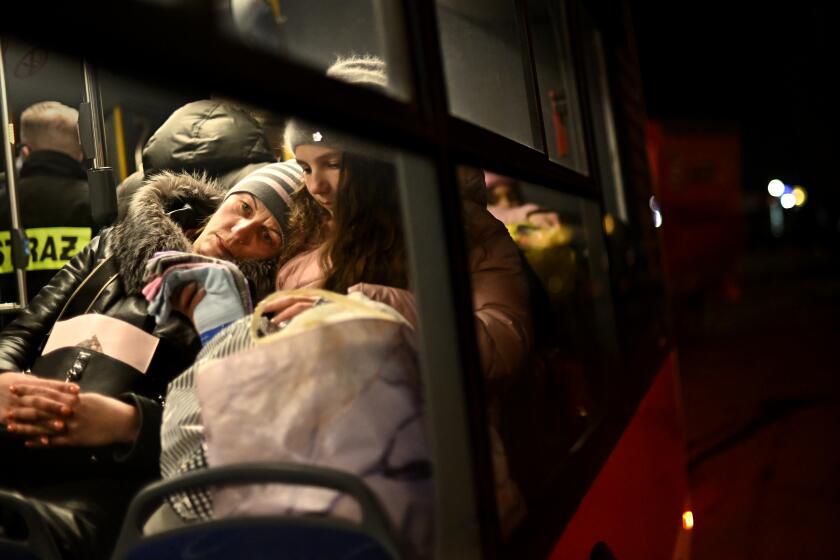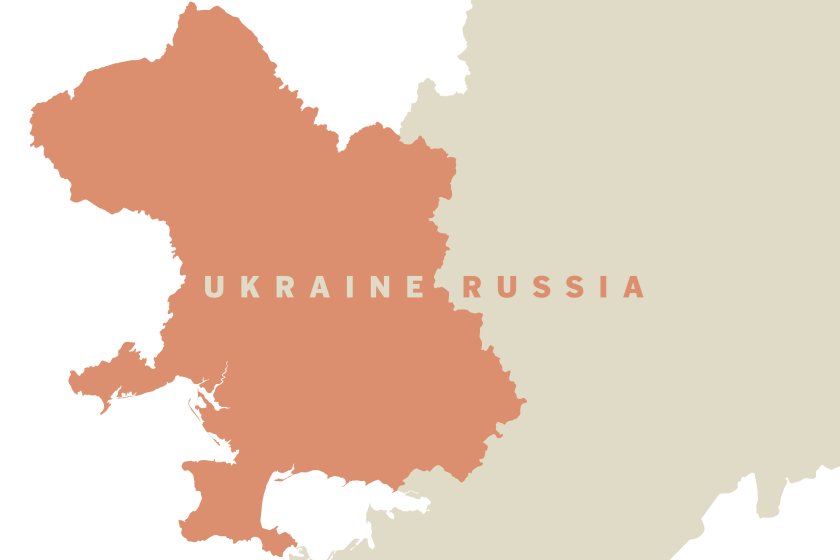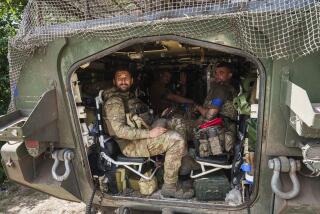Civilian suffering intensifies as new Russian-Ukrainian talks fail to yield breakthrough

- Share via
KYIV, Ukraine — A dozen days into a devastating war and a burgeoning refugee crisis, Russian forces on Monday launched withering new attacks on civilian areas and strategic centers in Ukraine, seeking to cripple the country’s defenses and establish supremacy over its vital Black Sea coast.
Amid a deepening humanitarian catastrophe in besieged Ukrainian cities and towns, representatives for the two sides held a third round of talks Monday, but reported no political progress toward ending Europe’s biggest ground war in decades. A Ukrainian negotiator reported some “small positive shifts” on logistical arrangements for setting up humanitarian corridors as soon as Tuesday.
Earlier Monday, for the third time since the weekend, Russia announced a new cease-fire to allow civilians to escape four beleaguered Ukrainian cities, but there was little sign that its forces would honor that pledge. In some cities and towns, food, water and power dwindled and then ran out.
Shelling attacks drew closer to the outskirts of the capital, Kyiv, even as a massive Russian convoy remained at a near-standstill less than 20 miles to the north. The city bristled with makeshift defenses — sandbags, old tires, tree branches — as its mayor, Vitali Klitschko, vowed that defenders would fight to the death at “every house, every street, every checkpoint.”
Although the scale of suffering grows daily, Russian President Vladimir Putin’s apparent aim — to swiftly bludgeon Ukraine into submission — appears to be foundering, even if he ultimately brings its leadership to heel.
Western military analysts and officials have cited a plethora of factors, including Russian forces’ supply problems, low troop morale and tactical blunders — in combination with a furious Ukrainian defense, by regular and irregular fighters, which clearly surpassed Kremlin expectations. Late Monday, the Ukrainian military said it shot down two Russian warplanes over Kyiv.
In another sign that Moscow might be worried about underperformance, there were indications that Russia was looking to recruit Syrians to aid in its Ukraine military effort, a senior U.S. defense official told reporters on Monday.
But the Russians are bringing vastly superior firepower to the fight, notably in their onslaught in the south. A senior Pentagon official who briefed reporters Monday said nearly 100% of the Russian troops pre-positioned by Putin outside Ukraine were now involved. Moreover, if Russian forces compensate for being bogged down in some areas with tactics such as bombardment and airstrikes, civilians will continue to bear the brunt.
The Biden administration, meanwhile, has sought to bolster European allies, especially those on NATO’s eastern flank. The Pentagon said Monday that it had deployed 500 additional troops to Europe in support roles such as refueling.
As the Russian offensive has widened, hundreds of thousands of Ukrainians remain trapped in their homes; some have died while trying to flee, including an entire family killed on a suburban Kyiv road that President Volodymyr Zelensky likened to “a shooting gallery” for invading troops.
Russia has proposed corridors of evacuation that would funnel refugees to Russia and to its ally Belarus, from which Russian troops rolled into northern Ukraine. That drew scathing rejoinders from Ukrainian and Western officials.
“This is an unacceptable option for opening humanitarian corridors,” Ukrainian Deputy Prime Minister Irina Vereshchuk said at a news briefing. The Ukrainian government has proposed alternative routes.
“Providing evacuation routes into the arms of the country that is currently destroying yours is a nonsense,” said James Cleverly, Britain’s minister for Europe. French President Emmanuel Macron deemed the Russian offer “political and moral cynicism.”
Almost all of the more than 1.7 million people who have escaped Ukraine in the last two weeks have gone west, to countries such as Poland and Hungary, in what the United Nations’ refugee agency chief called the fastest-growing refugee crisis in Europe since World War II. The exodus amounts to almost 4% of Ukraine’s entire population — akin to about 12.7 million Americans fleeing the United States.
Another southern Ukrainian city, Mykolaiv, awoke to renewed shelling Monday, Mayor Oleksandr Senkevich wrote on Facebook — a pounding that continued long into the day. But the regional governor said, after a day that included pitched fighting on the city’s outskirts, that defenders had held off a Russian assault.
“They are running away,” the governor, Vitaliy Kim, wrote on Facebook.
Taking over Mykolaiv has been a Russian objective for several days, as the city could serve as a key staging ground for a large-scale offensive against Odesa, which lies about 75 miles to the southwest and is Ukraine’s most vital access point to the Black Sea.
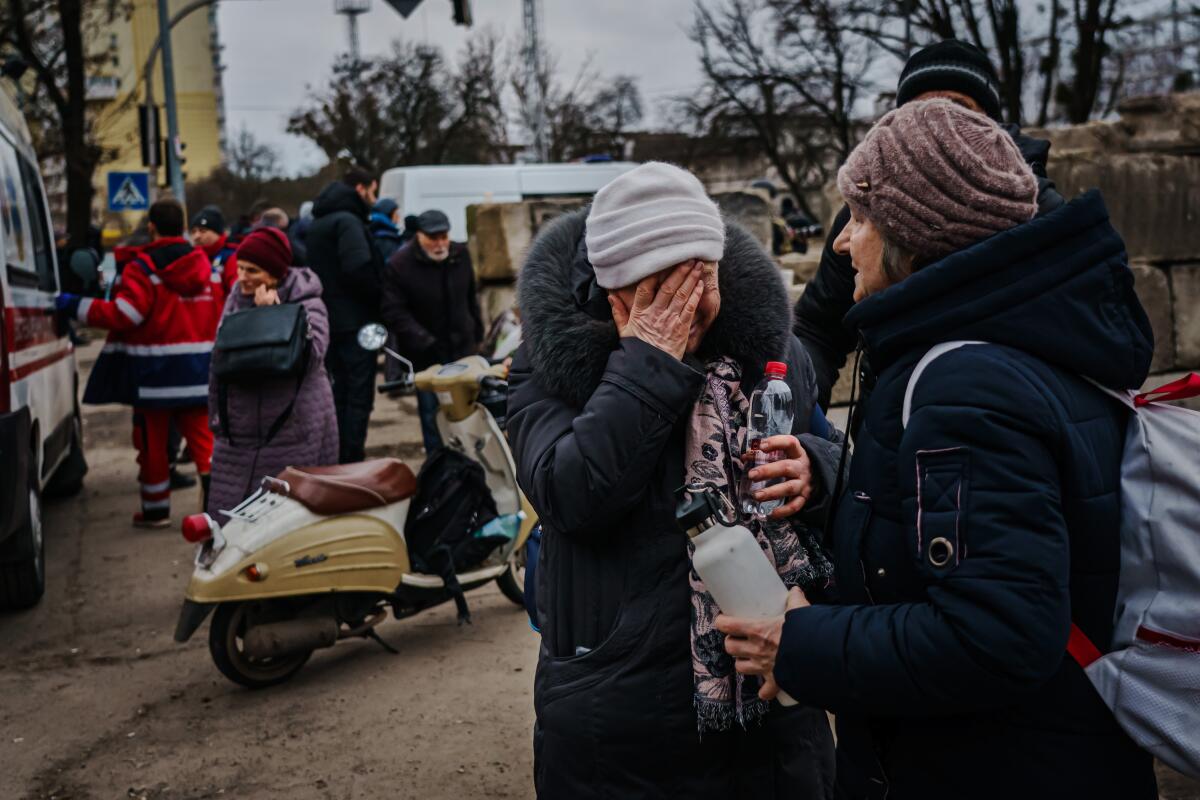
Senkevich accused Russian forces of deliberately targeting civilian apartment buildings, saying that attacks overnight had left wide swaths of Mykolaiv without heat. He posted a video showing what looked like a residential building, its center blackened by a blazing fire presumably caused by a shell.
Emergency crews were at work restoring service, he said. But he warned that there was a lot of unexploded ordnance around the city and that residents should keep their distance until authorities could remove them.
Reflecting the desperate circumstances facing civilians in suburbs northwest of Kyiv, authorities in Bucha, a town recently taken over by the Russian army, told residents to not try to escape on their own. The town’s mayor was wounded during the attempt to set up a safe corridor, Ukraine’s Foreign Ministry reported.
“We emphasize and warn that if you try to evacuate yourself, the chances of survival are 50/50,” said a post on the Bucha City Council’s official Facebook page. “DO NOT evacuate on your own!”
Each day, multi-generational Ukrainian families — grandparents, their children and grandchildren — arrive at borders in Poland and other neighboring nations. Meantime, would-be fighters and aid streams into Ukraine.
Both the two failed cease-fires had included the southern port city of Mariupol, where officials say Russian pummeling has taken a grievous toll in human life and on key infrastructure, cutting off water, electricity and food and medical supplies. Nearly half the city’s 430,000 residents are trying to flee, according to one estimate, but only a small fraction have succeeded.
In Kharkiv, the nation’s second-largest city, authorities said Monday that 209 people there, more than half of them civilians, have been killed since the invasion began.
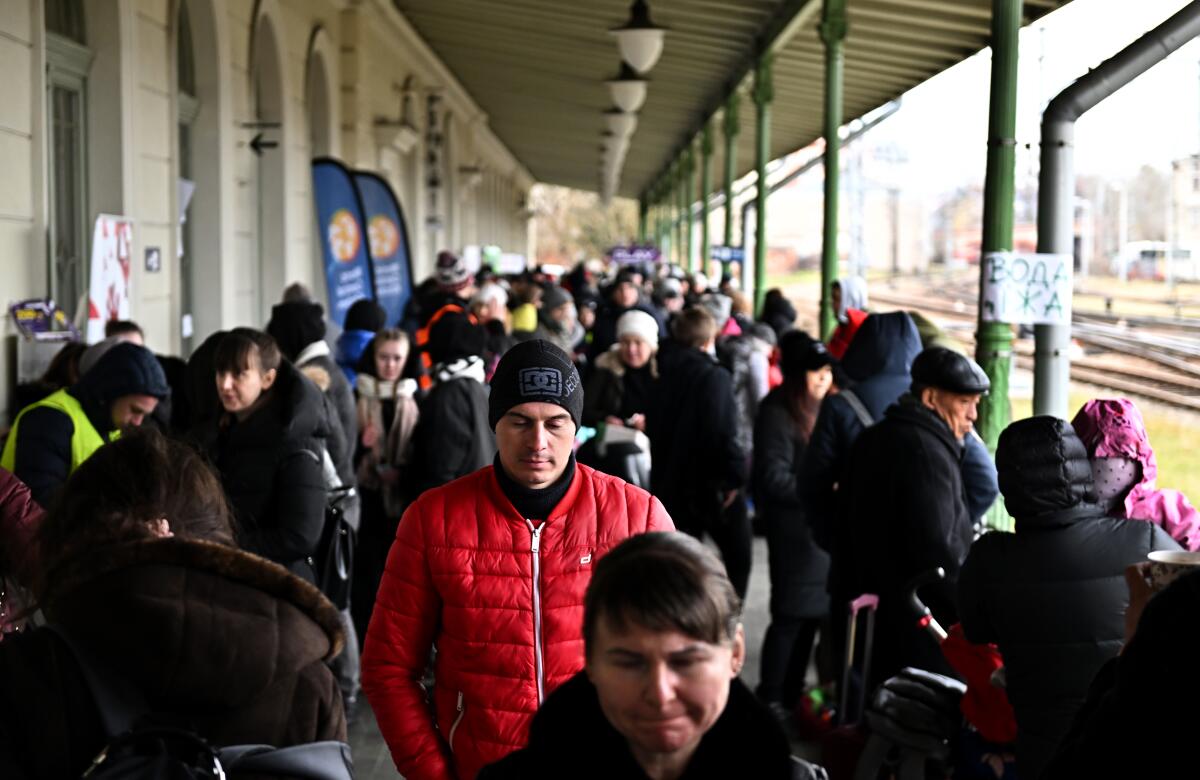
Putin has repeatedly insisted that he would end hostilities only if Kyiv capitulates to all his demands, which include accepting the loss of Crimea, which Russia seized in 2014, Ukraine’s “demilitarization” and a renunciation of any intention to try to join NATO.
For his part, Zelensky has implored NATO to establish a no-fly zone over Ukraine and grown increasingly angry over its rebuff of his request, which the transatlantic alliance says could lead to a larger, even more catastrophic armed confrontation between the West and Russia.
Russian forces have been seeking to home in on Ukrainian airstrips and airfields; Zelensky said the airport at Vinnytsia, about 120 miles southwest of Kyiv, had been “completely destroyed.”
In a video address Monday, the Ukrainian president also called for an international boycott of Russian oil, one of Moscow’s most important sources of revenue.
On Sunday, House Speaker Nancy Pelosi (D-San Francisco) said U.S. lawmakers were exploring such a ban. Heavy Western sanctions have already delivered a blow to Russia’s economy, with the ruble plunging in value, multinational companies pulling out and the Moscow stock exchange all but frozen, and some U.S. officials have called for more.
“We’re raising the cost on the Kremlin and all who aid and enable it for continuing this war of choice,” Secretary of State Antony J. Blinken said Monday during a visit to Lithuania, adding: “We want this to come to a stop as quickly as possible, which is why we’ll continue to increase pressure on Russia, continue to support Ukraine.”
Russia was an international foot dragger on climate solutions before it invaded Ukraine, but it was cooperating on Arctic issues. Are those days over?
Putin warned over the weekend that the West’s economic crackdown was close to a “declaration of war.” He launched the incursion baselessly claiming that Ukraine’s democratically elected leadership was a neo-Nazi cabal bent on wiping out ethnic Russians in the country’s east.
On Monday, a spokesman for the Russian Defense Ministry told reporters that 2,396 “military infrastructure facilities” had been destroyed in Ukraine since the start of the “special operation” — Russia’s term for the invasion of its neighbor.
The information the spokesman provided could not be independently verified.
Putin has ignored international condemnation of the invasion, and in keeping with that pattern, Russian representatives were a no-show at a hearing Monday at the International Court of Justice in The Hague, where Kyiv accused Moscow of war crimes.
Breaking News
Get breaking news, investigations, analysis and more signature journalism from the Los Angeles Times in your inbox.
You may occasionally receive promotional content from the Los Angeles Times.
Although there is little reason to think the Kremlin would heed a call by the court to desist, Ukraine’s representative, Anton Korynevych, appealed to the judges to order Russia to halt its attacks.
Putin has also sought to keep a tight lid on information about the conflict’s costs. Moscow has acknowledged the deaths of nearly 500 Russian soldiers. But Ukraine’s Defense Ministry said Monday that the Russian army has lost more than 11,000 service personnel, more than 1,000 tanks and armored vehicles, and more than 100 aircraft and helicopters. The figures could not be independently verified.
Swaths of Ukraine have fallen into Russian hands. Corpses scattered in the snow. Rockets rain daily on civilians. The capital, Kyiv, waits in cruel limbo for advancing Russian forces.
The Biden administration has accused Russian troops of targeting civilians, an allegation Putin denies, although Russian forces and their proxies leveled cities during conflicts in Chechnya and Syria at the cost of thousands of lives.
With the Kremlin in effect banning independent reporting in Russia on the war, many in the country have accepted the government line on the invasion. But the war has not been without domestic opposition: Protests around the country on Sunday, from Siberia to St. Petersburg, resulted in the arrests of more than 4,600 people, according to the rights group OVD-Info.
Bulos reported from Kyiv, King from Washington and Chu from London. Times staff writer Tracy Wilkinson, Anumita Kaur and Eli Stokols in Washington contributed to this report.
More to Read
Sign up for Essential California
The most important California stories and recommendations in your inbox every morning.
You may occasionally receive promotional content from the Los Angeles Times.
